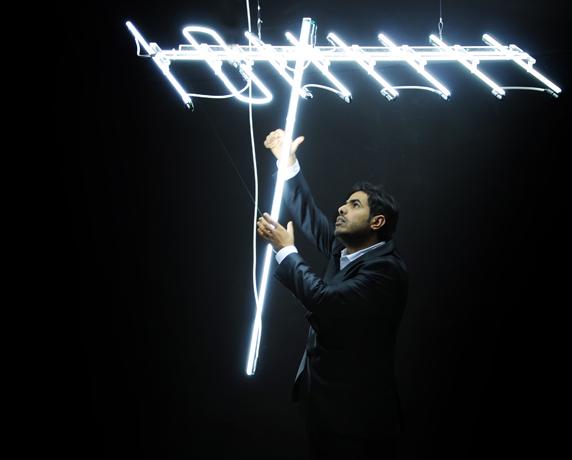‘Symbolic Cities: The Work of Ahmed Mater’ at the Sackler
By • June 8, 2016 0 1067

Since the early 20th century, Saudi Arabia has experienced extraordinary political, economic and social transformation. However, the only perspective that most of America has been given for understanding this distant cultural landscape — the political patterns of which are so integral to our globalized economy — is the fractured, often spotty interpretation of our national media lens.
But an exhibition in Washington is currently working to change that, opening the doors to a cross-cultural exchange without the constraints of language barriers, using art and visual imagery to offer a uniquely contemporary dialogue about a modern-day international powerhouse.
Currently on view at the Smithsonian’s Arthur M. Sackler Gallery (the connected Freer Gallery of Art remains closed for renovation) is “Symbolic Cities: The Work of Ahmed Mater,” the first-ever solo exhibition by a Saudi artist at an American museum.
The fascinating photographs and videos in this show present an alternative narrative to the images of the desert kingdom, revealing the recent urban development of the Saudi landscape and offering an essential archive — or as Mater calls it, an “unofficial history” — of contemporary Saudi Arabia at a time of profound social and political change.
Born in 1979 in southern Saudi Arabia and trained as a doctor, Mater has been a practicing artist since the early 1990s. Now based in Jeddah, Mater has focused primarily on photography and video since 2010.
From abandoned desert cities to the extraordinary transformation of Mecca, “Symbolic Cities” presents his journeys observing economic and urban change in Saudi Arabia. The exhibition also debuts new works based on his extensive research on the development of Saudi Arabia’s administrative capital and largest city, Riyadh.
While Mater works in a variety of media, including painting, installations and performance, “Symbolic Cities” focuses on his landscape photography as a means of exploring the tension between the traditional world and the realities of contemporary Saudi Arabian life.
The show highlights three journeys through Saudi Arabia, with an eye toward the impact of urbanization: “Empty Land,” “Desert of Pharan” and “Ashab Al-Lal/Fault Mirage.”
Beginning with his aerial views of abandoned desert sites and continuing through the reconstruction of Mecca, a series of large-scale photographs and videos are organized as experiential encounters, a progression from quiet emptiness to the physical and emotional intensity of the changes Mater is witnessing in his country.
The exhibition culminates with the installation “Ashab Al-Lal/Fault Mirage: A Thousand Lost Years,” the first chapter in Mater’s latest project, examining the growth of Riyadh.
However, the focus of “Symbolic Cities” is on Mecca, Islam’s holiest city and the destination of the annual hajj pilgrimage made by observant Muslims, a city which has long intrigued outsiders because it is off-limits to non-Muslims. The exhibition’s centerpiece is “Golden Hour,” a large photograph chronicling the transformation of central Mecca, shot by Mater in 2011 from atop a construction crane placed where a mountain once stood. Exhibition curator Carol Huh, the museum’s curator of contemporary art, calls it “the iconic image of the series.”
Oddly, perhaps the most interesting thing about this monumental and transfixing image is the background; far from Mecca’s symbolic sights is a glimpse of the urban sprawl of a city now home to well over a million people.
“Mater brings the rigor of his training as a physician — as well as unparalleled access — to gather frank observations of his own time and place,” said Huh. “The resulting imagery is straightforward and striking, while his newest research-based project presents another fascinating shift in his use of the photographic medium.”
On view through Sept. 18, “Symbolic Cities” is the second in a series of exhibitions highlighting artists and works in the museum’s growing collection of contemporary photography. This is one not to be missed.

